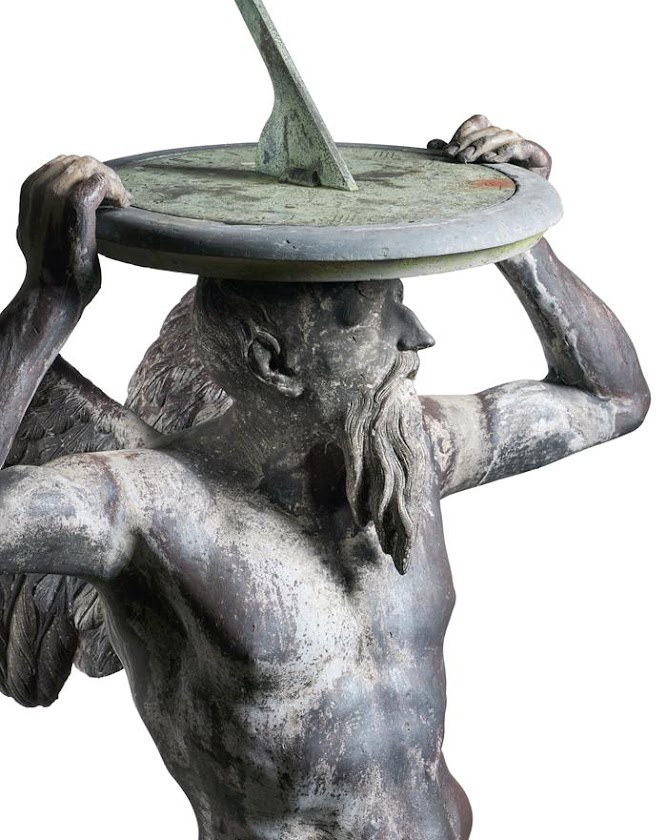From The Collection from Flaxley Abbey: An Oliver Messel Commission.
Flaxley, Forest of Dean, Glouc.
3 October 2022, Lot 290.
152cm high overall.
The maker of the bronze sundial was Benjamin Martin who worked between 1738 and 1777 from one address in Chichester and five in Fleet Street and latterly as Benjamin Martin & Son until 1782 when the firm went bankrupt.
Attributed to John Cheere from a model originally conceived by John van Nost!
The solid gnomon and dial above the crouching figure of Father Time or Kronos, the dial signed "B Martin London and indistinctly engraved with the Boevey escutcheon of arms the base 92cm wide 74cm deepProvenance:Possibly acquired by Thomas Crawley-Boevey, 1st Bt. of Flaxley (1709-69), at the time of his marriage to Susanna (née Lloyd) in May 1743, and by descent at Flaxley Abbey, Gloucestershire.
It was sold at auction and removed from the premises of Flaxley Abbey, Gloucestershire.
Flaxley Abbey, Gloucestershire: Catalogue of the Valuable Contents, Bruton, Knowles & Co., 29 March - 5 April 1960, lot 1009.
There are two similar sundials of this particular kneeling form of
Time. One, shown on a receipt dated for 1743 by John Cheere, was at Blair Castle, Perthshire (RCAHMS SC 763911).
Another version of Father Time was formerly at St. Osyth
Priory, Essex- however it has been noted that this one was of a slightly
different form- with just one hand holding the plate above. It was listed in
the house sale of 1920 as: 'A fine XVII cent. cast lead figure of Time
supporting a sundial, 3' 6" high on a square stone base' (In fact, it was
18th century and life-size). The sundial failed to sell, and remained at St.
Osyth Priory until 1986; its present whereabouts are unknown.
An almost identical sundial to this lot was offered for sale by Seago Antique Garden Furniture, formerly at 22 Pimlico Road London, and illustrated at the back of John Davis "Antique Garden Ornament" (Antique Collector's Club 1991).
The Seago lead statue of Father Time is recorded with provenance for
Fonthill House, Wiltshire, home of Alderman William Beckford. Unfortunately its
current whereabouts is unknown and the maker of the sundial plate unrecorded.
...........................
The trade Card of Benjamin Martin.
Image courtesy Science Museum.
https://collection.sciencemuseumgroup.org.uk/search?q=Benjamin%20Martin
......................
The Fonthill Lead Statue of Father Time.
................................
Chronos/ Time.
Limestone.
The Wings have been broken off.
1880 x 800 x 840 mm.
Anglesey Abbey, Cambridge.
The usual poor quality National Trust Image!
https://www.nationaltrustcollections.org.uk/object/516672
https://www.nationaltrustcollections.org.uk/object/516672
............................
The Duncombe Park Chronos / Time.
Probably by John van Nost.
Duncombe Park near Helmsley, North Yorkshire.
Probably Portland Stone.
The house was completed in 1713 for Thomas Duncombe (born Thomas Brown) to designs by the Yorkshire gentleman-architect William Wakefield.
It was remodelled in 1843 by Sir Charles Barry. In 1879 the main block was gutted by fire and remained a ruin until 1895 when rebuilding was carried out by William Young.
The Sundial is perhaps contemporary with the building of the house in 1715.
It was possibly carved by John van Nost II (d.1729) the nephew of John van Nost I (d.1710).
or by Andreas Carpentier the assistant of John van Nost I
Al three had workshops at Stone Bridge Portugal Row by Hyde Park Corner.
https://commons.wikimedia.org/wiki/File:Duncombe_Park_Father_Time_Sundial_and_Ionic_Temple_01.jpg
Images below from the excellent di Camillo website.
https://www.thedicamillo.com/house/duncombe-park/





























